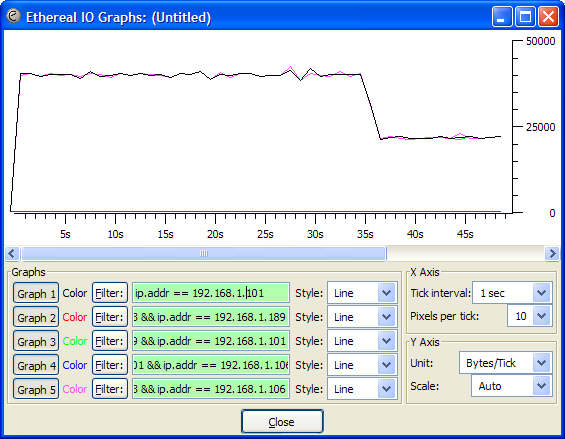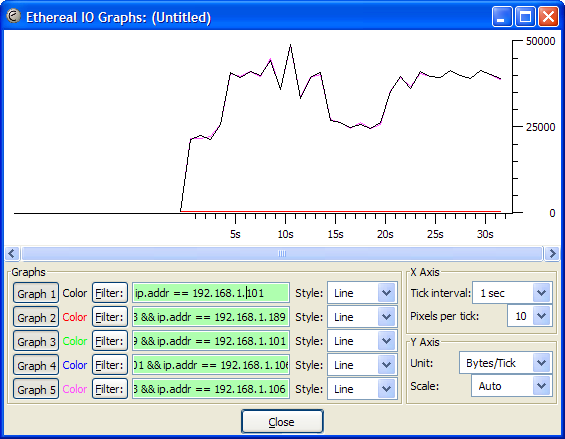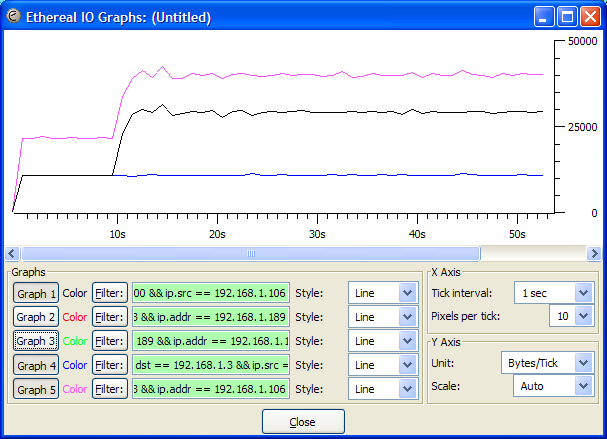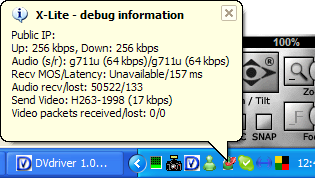Difference between revisions of "Traffic measurements Video"
| (25 intermediate revisions by 2 users not shown) | |||
| Line 31: | Line 31: | ||
As we see from the graph shown above, the used bandwidth for audio-only is approximately 22500 bytes/second while the used bandwidth for audio and voice is approximately 40000 bytes/second. | As we see from the graph shown above, the used bandwidth for audio-only is approximately 22500 bytes/second while the used bandwidth for audio and voice is approximately 40000 bytes/second. | ||
| − | For the audio codec the 22500 bytes/second corresponds to 22500*8/1000 = | + | For the audio codec the 22500 bytes/second corresponds to 22500*8/1000 = 180 kbps. Because this is traffic in two directions, (180/2 =) 90 kbps is the traffic in one direction. The expected Nominal Ethernet Bandwidth (one direction), also called NEB is 87.2 kbps which corresponds reasonably with the measured 90 kbps. The g711u has a transfer rate of 64 kbps and the difference between the NEB and this transfer rate (~ 90-64=16 kbps) is packet overhead. |
| + | |||
| + | The video uses approximately (40000-22500)*8/1000 = 140 kbps. In one direction, the NEB of the H263(1998) is 70 kbps. | ||
== Conclusions == | == Conclusions == | ||
| − | * First of all, there can be seen from the screenshots shown above that the red line can be represented by (y=0). Because the red line represents the traffic between the 2 Windows machines running X-lite we can conclude that there is no direct traffic between the X-Lites. | + | * First of all, there can be seen from the screenshots shown above that the red line can be represented by (y=0), meaning no traffic. Because the red line represents the traffic between the 2 Windows machines running X-lite we can conclude that ''there is no direct traffic between the X-Lites''. |
| − | * Secondly, there can be seen from the second screenshot that the black, green, blue and pink line represent all the same amount of data traffic. From this there can be concluded that the traffic between the Trixboxes is the same as the triffic to and from the Trixboxes, i.e. the traffic is not limited between the Trixboxes. | + | * Secondly, there can be seen from the second screenshot that the black, green, blue and pink line represent all the same amount of data traffic. From this there can be concluded that the traffic between the Trixboxes is the same as the triffic to and from the Trixboxes, ''i.e. the traffic is not limited between the Trixboxes.'' |
| − | * | + | * The NEB of the g711u (87.2 kbps) corresponds very well to the measured voice traffic in one direction (90 kbps) between the SIP-phones and their Trixboxes and the Trixboxes mutually. |
| + | * The NEB of the H263(1998) is found to be 70 Kpbs. | ||
= Differences between voice and video = | = Differences between voice and video = | ||
| Line 58: | Line 61: | ||
| − | * The debug-screen [[image:X-lite debug-info.png|right|315px|X-lite debug-screen]] of X-lite (Ctrl + F9) told us the SIP-phone assumed a total available bandwith of 256/256 kbps. This was filled with 64 kbps for speech (protocol g711u) and 131 kbps for video (protocol H263-1998). | + | * First we will analyse the blue line. This is the audio-only traffic from SIP-phone #2 to its PBX. The measured traffic is found to be approximately 11000 kBps which corresonds to 11000*8/1000=88kbps. This corresponds well with the expected NEB value of the g711u codec. |
| − | + | * Secondly, we will analyse the black line. This is the audio & video traffic from Sip-phone #1 to its PBX. The traffic is measured to be 30000 kBps which corresponds to 30000*8/1000 = 240kbps. The amount of audio-traffic is 88kbps which leaves (240-88=)152 kbps for the video traffic. | |
| + | * The debug-screen [[image:X-lite debug-info.png|right|315px|X-lite debug-screen. Numbers in this screenshot do not reflect the situation sketched.]] of X-lite (Ctrl + F9) told us the SIP-phone assumed a total available bandwith of 256/256 kbps. This was filled with 64 kbps for speech (protocol g711u) and 131 kbps for video (protocol H263-1998). This gives us the overhead of the voice (88-64=)24 kbps and for the video (152-131)=21 kpbs. | ||
* When looking at the speech traffic: | * When looking at the speech traffic: | ||
| − | ** 50 packets/sec (measured with Ethereal) | + | ** 50 packets/sec (measured with Ethereal) are sent which corresponds to 214 Bytes/packet (measured with Ethereal). This makes a total of (50*214=) 10,7 kBps. |
| − | + | ** The g711u codec uses a bitrate of 64 kpbs which is 8 kBps. This traffic is sent with 50 packets/second, so there is 160 bytes of audio-data per packet. | |
| − | * | + | ** [[Ethernet payload datarates|UDP-packet-header: 28 Bytes]] |
| − | ** 160 bytes audio-data per packet | + | * The Measured IAX-overhead is 214 - 28 - 160 = 26 Bytes/packet. Because 50 packets are send per second, 1300 Bytes/sec is the IAX overhead (10k4 bps). |
| − | ** UDP-packet-header: 28 Bytes | ||
| − | |||
| − | * Measured IAX-overhead | ||
== Conclusions == | == Conclusions == | ||
| − | * | + | * The measured audio-traffic (88kbps) corresponds very well to the NEB value of the g911u codec (87,2 kpbs). |
| + | * The measured video-traffic was found to be 152 kpbs in one direction. If compared with the video traffic of 70 kbps in the section above, this is almost twice as much. This increase is due to the fact that in the former experiment there was much movement (i.e. waving) leading to the fact that less compression could be achieved by the H263 codec. | ||
Latest revision as of 12:56, 23 February 2007
Contents
Voice and video analysis
Experimental Setup
In words the configuration is the following: SIP phone #1 is connected to Asterisk #1 and SIP phone #2 is connected to Asterisk #2. The SIP phones are not directly connected to each other but can communicate with each other because Asterisk #1 is directly connected to Asterisk #2 (and vica versa).
Arrows represent possible data traffic that will be measured (see results).
Codecs used: g711u for audio and H263(1998) for video
Results
In the screenshot below, the following holds:
- @4 sec: Video was turned on
- @14 sec: Video was set to black (connection lost with DVdriver)
- @20 sec: Video showed moving pictures again.
In the screenshot below, the conversation included audio and video until t = 35s. After t = 35s, the traffic is audio-only.

Legenda:
- Black: traffic from and to Trixbox #1
- Red: traffic between the 2 Windows machines running X-lite
- Green: traffic between laptop #1 and its Asterisk
- Blue: traffic between the two Asterisk PBX's
- Pink: traffic between Windows machine #1 and its Asterisk
As we see from the graph shown above, the used bandwidth for audio-only is approximately 22500 bytes/second while the used bandwidth for audio and voice is approximately 40000 bytes/second. For the audio codec the 22500 bytes/second corresponds to 22500*8/1000 = 180 kbps. Because this is traffic in two directions, (180/2 =) 90 kbps is the traffic in one direction. The expected Nominal Ethernet Bandwidth (one direction), also called NEB is 87.2 kbps which corresponds reasonably with the measured 90 kbps. The g711u has a transfer rate of 64 kbps and the difference between the NEB and this transfer rate (~ 90-64=16 kbps) is packet overhead.
The video uses approximately (40000-22500)*8/1000 = 140 kbps. In one direction, the NEB of the H263(1998) is 70 kbps.
Conclusions
- First of all, there can be seen from the screenshots shown above that the red line can be represented by (y=0), meaning no traffic. Because the red line represents the traffic between the 2 Windows machines running X-lite we can conclude that there is no direct traffic between the X-Lites.
- Secondly, there can be seen from the second screenshot that the black, green, blue and pink line represent all the same amount of data traffic. From this there can be concluded that the traffic between the Trixboxes is the same as the triffic to and from the Trixboxes, i.e. the traffic is not limited between the Trixboxes.
- The NEB of the g711u (87.2 kbps) corresponds very well to the measured voice traffic in one direction (90 kbps) between the SIP-phones and their Trixboxes and the Trixboxes mutually.
- The NEB of the H263(1998) is found to be 70 Kpbs.
Differences between voice and video
Experimental Setup
Two SIP phones are connected to the same Asterisk PBX Trixbox. One SIP phone is equiped with a camera while the other is not. The bandwidth usage is measured between the Trixbox and the SIP phones connected to it.
Results
Data is collected using WireShark and the data is stored here: (captured Ethereal data)
Legenda:
- Black shows audio & video from SIP-phone #1 to the PBX (video starting at the 10th second)
- Blue shows audio-only from SIP-phone #2 to the PBX
- Pink shows all traffic between SIP-phone #1 and the PBX (both directions)
- First we will analyse the blue line. This is the audio-only traffic from SIP-phone #2 to its PBX. The measured traffic is found to be approximately 11000 kBps which corresonds to 11000*8/1000=88kbps. This corresponds well with the expected NEB value of the g711u codec.
- Secondly, we will analyse the black line. This is the audio & video traffic from Sip-phone #1 to its PBX. The traffic is measured to be 30000 kBps which corresponds to 30000*8/1000 = 240kbps. The amount of audio-traffic is 88kbps which leaves (240-88=)152 kbps for the video traffic.
- The debug-screen of X-lite (Ctrl + F9) told us the SIP-phone assumed a total available bandwith of 256/256 kbps. This was filled with 64 kbps for speech (protocol g711u) and 131 kbps for video (protocol H263-1998). This gives us the overhead of the voice (88-64=)24 kbps and for the video (152-131)=21 kpbs.
- When looking at the speech traffic:
- 50 packets/sec (measured with Ethereal) are sent which corresponds to 214 Bytes/packet (measured with Ethereal). This makes a total of (50*214=) 10,7 kBps.
- The g711u codec uses a bitrate of 64 kpbs which is 8 kBps. This traffic is sent with 50 packets/second, so there is 160 bytes of audio-data per packet.
- UDP-packet-header: 28 Bytes
- The Measured IAX-overhead is 214 - 28 - 160 = 26 Bytes/packet. Because 50 packets are send per second, 1300 Bytes/sec is the IAX overhead (10k4 bps).
Conclusions
- The measured audio-traffic (88kbps) corresponds very well to the NEB value of the g911u codec (87,2 kpbs).
- The measured video-traffic was found to be 152 kpbs in one direction. If compared with the video traffic of 70 kbps in the section above, this is almost twice as much. This increase is due to the fact that in the former experiment there was much movement (i.e. waving) leading to the fact that less compression could be achieved by the H263 codec.



